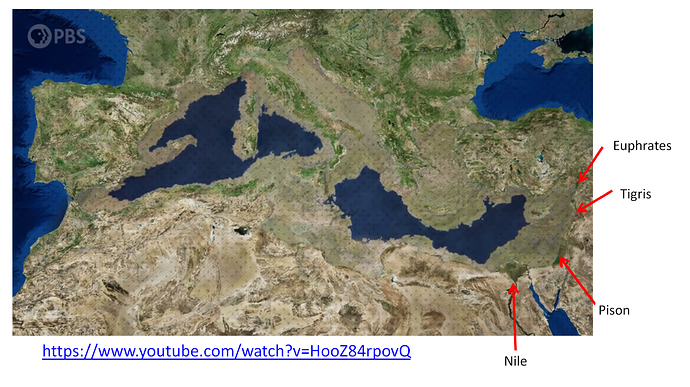As I survey the world of views on Adam and who he was, one thing struck me while I was sick in bed last week–Christians seem to require that Adam not be evolved, that is, that he, like us, is an anatomically modern human. And the vast majority of views say Adam must have lived when the YECs say Adam must have lived–within the past 10 kyrs. Others who believe Adam was 200,000 years ago, still believe he had to be an anatomically modern human. In other words, it seems that a key modern Christian doctrine is that Adam must be physically like us. We seem to be saying that God could not put his image in anything that doesn’t look like us. I reject that view.
What evidence do I have for this claim? First, every YEC says Adam lived within the past 10,000 years, so I don’t need to discuss any of them. Their Adam is almost always considered to be an H. sapiens . Archaic species if granted human status are degenerates from Adam.
With the old earthers, Let’s start with Hugh Ross, who believes the universe evolved, but not biology. Poor Hugh has constantly but grudgingly been moving Adam backward in time.
"While bipedal, tool-using, large brained hominids roamed the earth at least as long ago as one million years, evidence for religious relics and altars dates back only 8,000 to 24,000 years . Thus the secular anthropological date for the first spirit creatures is in complete agreement with the biblical date ." Hugh Ross, The Fingerprint of God, (Orange: Promise Publishing, 1991), p. 159-160.
By 1995, Ross had moved the oldest possible Adamic date back to 60,000 years ago.
" However, the dates for these finds are well within the biblically acceptable range for the appearance of Adam and Eve __ somewhere between 10,000 and 60,000 years ago according to Bible scholars who have carefully analyzed the genealogies. Since the oldest art and fabrics date between 25,000 and 30,000 years ago, no contradiction exists between anthropology and Scripture on this issue ." Hugh Ross, “Art and Fabric Shed New Light on Human History,” Facts & Faith, 9:3 (1995)p. 2
Then in 2005 Rana and Ross say 100kyr old Adam might work out:
" Gaps in the genealogies and the ambiguity of key words in the original Hebrew text render the best attempts at a biblical date for Adam and Eve as estimates only. If few gaps exist, the date calculates to around 10,000 years ago. If many gaps occur, the date falls closer to 100,000 years ago. " Fazale Rana and Hugh Ross, Who Was Adam?, (Colorado Springs: NavPress, 2005), p.45
Today they say:
When did Adam and Eve live? … The consistency of these three independent lines of evidence instills some confidence that Adam and Eve lived somewhere between 50,000 and 150,000 years ago . This date fits within the Biblical framework and strongly argues for a recent origin of humanity. https://reasons.org/explore/publications/rtb-101/age-of-adam
But all throughout this time, they have vehemently denied that Neanderthals interbred with humanity, that Neanderthals were anything other than primates. and have insisted that Adam and Eve are anatomically modern humans–no evolution for us. From Feb 19, 2020:
"RTB’s human origins model regards Neanderthals (and other hominins) as creatures made by God, without any evolutionary connection to modern humans. " Ancient DNA Indicates Modern Humans Are One-of-a-Kind - Reasons to Believe
As we will see, RTB is hopelessly incapable of dealing with the recent DNA data. We non-Africans have Neanderthal DNA inside each of our cells.
Ok, what about people like Dick Fischer in The Origins Solution? Again, no evolution for spiritual mankind. Adam is a full-fledged H. sapiens!
" Genesis 4:22. One of Cain’s descendants, Tubal-Cain, was ‘an instructor of every worker in brass and iron.’
"This is the proverbial smoking gun! Adam belongs after the old Stone Ages, at the end of the Neolithic, at the threshold of a period called the Chalcolithic when traditional stone tools were augmented by crude copper implements. Adam’s descendants saw the dawning of the Bronze Age ." ~ Dick Fischer, The Origins Solution, (Lima, Ohio: Fairway Press, 1996), p. 239
As I explain here, brass and iron is a euphemism for corruption. and in the post after that, an even better explanation for the corruption analogy is presented by Phil McCurdy. But regardless, Dick posits Adam as one of us. People alive at the end of the Neolithic were, H. sapiens , that is, modern humans. Again, Christians of the old earth variety require that Adam be physically like us, and living when YECs say he did!
My friend Jay Johnson told me last year that the population which got the image of God, language and morality, lived 65-75,000 years ago–again, these were modern humans because he cited the globularity of their brains and connected it to language. Erectine brains when viewed from above, look like a distorted hour-glass. They are not globular.
Interestingly, Swamidass also places Adam as a very recent person on earth, say around 12,000 years ago. It seems that he and Venema, while disagreeing on the nature of Adam, agree that he was an H. sapiens.
Dennis Venema, a person of esteem here on Biologos said:
" In Adam and the Genome I consistently discuss humans as a species arising ~200,000 years ago. So, by your calculations, Zhao (2000) supports my case - human variation in this all region of the genome cannot be reasonably explained by a bottleneck to 2 individuals within human history, as I argue in AatG. Am I missing something here? I want to be sure I’m reading you correctly." Adam, Eve and Population Genetics: A Reply to Dr. Richard Buggs (Part 1) - #249 by Swamidass
He and Scot McKnight wrote the book mentioned above. Venema uses the minimum effective population size of modern humans as a hammer to pound the historical Adam and Eve out of the Bible. No bottle neck of 2 people has happened in human history. But those statistics only apply to the last 200,000 years of anatomically modern man. What if Adam wasn’t an anatomically modern human, and we Christians fully accept our evolutionary heritage rather than acting as if God can only put the his image into a vessel that looks like us?
George Murphy gets confused when he addresses this issue. He uses the statistics above, which are applicable only to anatomically modern people and then discusses briefly other hominids being human. He cites a problem I had worried about for about 20 years before finding a solution–the Major Histocompatibility Complex.
" The theological proposal to be made here does not depend on the number of hominids to be considered the first humans or on when they came into being. But it does seem unlikely that the present human race can be traced to a single male-female pair. As one example of the difficulty this idea faces, development of the present diversity of alleles of human histocompatibility genes from such a pair would require between five and ten million years. Unless we want to consider ’ Adam and Eve ’ the biological ancestors of all hominids, and perhaps even pongids, we must rule this out . "George L Murphy, Roads to Paradise and Perdition: Christ, Evolution, and Original Sin, Perspectives on Science and Christian Faith, June 2006, p. 114
While I do want to declare Adam and Eve the parents of the hominids, I wouldn’t go so far as the pongids, nor do I think we need to. Like George, I worried about the Major histocompatibility complex and its implications for not allowing a population bottleneck of two people. At the time I wrote my book, Adam, Apes and Anthropology, the widespread view among many atheists I knew at the time was that of Ayala:
" The human immune system DRB1 genes are extremely polymorphic, with gene lineages that coalesce into an ancestor who lived around 60 million years ago, a time before the divergence of the apes from the Old World monkeys ." Francis J. Ayala, “The Myth of Eve: Molecular Biology and Human Origins,” Science, 270(1995):1930-1936, p. 1932
Now obviously that won’t do. George gave up on the problem too early. The answer was out there shortly after I wrote my book and long before George wrote the above article. I, however didn’t find out about it until about a year and a half ago. Ayala’s calculation was based upon single nucleotide mutation driving the entire MHC polymorphism, which would indeed take 60 myr. But in 1998 it was discovered that both cross-over and recombination occurs in the MHC regions:
" Some new alleles are the result of point mutations, but many arise from the combination of sequences from different alleles either by genetic recombination or by gene conversion, a process in which one sequence is replaced, in part, by another from a different gene (Fig. 5.19). " Janeway CA Jr, Travers P, Walport M, et a, Immunobiology: The Immune System in Health and Disease. 5th edition. The major histocompatibility complex and its functions - Immunobiology - NCBI Bookshelf
" Sequences can be transferred from one gene to a similar but different gene by a process known as gene conversion. For this to happen, the two genes must become apposed during meiosis. This can occur as a consequence of the misalignment of the two paired homologous chromosomes when there are many copies of similar genes arrayed in tandem - somewhat like buttoning in the wrong buttonhole. During the process of crossing-over and DNA recombination, a DNA sequence from one chromosome is sometimes copied to the other, replacing the original sequence. In this way several nucleotide changes can be inserted all at once into a gene and can cause several simultaneous amino acid changes between the new gene sequence and the original gene. Because of the similarity of the MHC genes to each other and their close linkage, gene conversion has occurred many times in the evolution of MHC alleles ." Janeway CA Jr, Travers P, Walport M, et a, Immunobiology: The Immune System in Health and Disease. 5th edition. The major histocompatibility complex and its functions - Immunobiology - NCBI Bookshelf
Once one throws gene conversion and recombination into the mechanisms of how to form MHC diversity, one can no longer use the rate of point mutation to date the age of the MHC alleles. In both processes, multiple nucleotides are traded at each gene conversion and crossing over/recombination. This clearly means that the rate of creation of alleles is much faster than point mutations and the age of the complex is much younger than 60 myr, and maybe undatable…
Once this MHC issue is gone we have no real obstacle to a single pair except our own bias. Most people don’t know that there is no definition of modernity which includes all modern humans and excludes all archaic species:
" The main problem with modernity, we think, is reflected in the fact that there is no worldwide definition of moderns that simultaneously includes all modern humans and excludes all archaics. If modern humans share a recent unique origin, definition of this group should be possible. However, it may not be possible if the multiregional model is correct." ~ Milford Wolpoff and Rachel Caspari, “The Modernity Mess,” Journal of Human Evolution, (1996), 30:167-171, p. 169
Indeed, a form of multiregionalism is now in vogue, where Neanderthals, Denisovians and a ghost archaic in Africa interbred with moderns. Were the offspring moderns? Given that some of their descendants are alive today would strongly suggest that. By comparison to other animals we can illustrate the problem:
" We feel that this quest for the beginnings of modernity is doomed to failure; we are seeking something that doesn’t exist. It is time, as P.V. Tobias recently said, to stop talking about ‘anatomically modern humans’ for the same reasons that we don’t talk about 'anatomically modern elephants '. And we propose, it is time to stop publishing papers about the evolution of ‘anatomically modern humans’ unless they include a definition of them. " ~ Milford Wolpoff and Rachel Caspari, “The Modernity Mess,” Journal of Human Evolution, (1996), 30:167-171, p. 170
Very OLD Genes
Moving Adam and Eve back in time, like I do, to 5.3 myr ago, we can have a historical Adam, and an evolutionary humanity. And we can explain the significant number of extremely old genes in humanity (old= old time to most recent common ancestor, like genes greater than 4 myr old). Garrigan and show the age of various genes.
One can see the haploid mtDNA and y-chromosome measurements are only for a very recent time scale and tell us nothing about when humanity arose. The average age of an autosomal gene is about a million years! Anatomically modern humans were not alive then, but we still have genes from those non-anatomically modern humans. The X chromosome and the other autosomal chromosomes show a great genetic time depth for humanity–a time depth Christians seem unwilling to grant.
Garrigan and Hammer suggest that if we modern humans interbred with archaic species, then that would mean we were never an isolated reproductive species.
" If the AMH genome contains any degree of dual ancestry (that is, archaic and modern) the single origin model must be rejected. Although most of the AMH genome might descend from a single African population, if further studies confirm a non-negligible contribution of archaic genetic material to the AMH genome , it would imply that the evolutionary lineage leading to AMH did not evolve reproductive isolation from other archaic hominin subpopulations and, therefore, cannot be considered a distinct biological species. " Daniel Garrigan and Michael Hammer, “Reconstructing Human Origins in the Genomic Era,” Nature Genetics, 7(2006), p. 677
Well, we have non-negligible input from at least 3 archaic populations, Neanderthals, Denisovians and a ghost population from Africa. And there is evidence that the Denisovans interbred with an even older archic from 1.8 myr ago. Asians and Europeans have 1.7 and 1.8 percent Neanderthal DNA respectively. Africans have .5% Neanderthal DNA. Melanesians, Australian aborigines, and polynesians have between 2 and 6% Denisovian DNA. (Wiki) . This year genetic evidence for an unknown archaic having interbred with some West African tribes. Anthropologists don’t know who this archaic is. But the genomes of the Mende of Sierra Leone, the Esan of Nigeria and the Yoruba of Nigeria, have from 2-19 percent of their genomes from this unknown archaic hominid.
Because the main place where Denisovian dna introgressed into humanity was in Papua New Guinea and Australia, Cooper and Stringer wonder if the Denisovians crossed the Wallace line and that would mean building steerable ships.
The data challenges our views of the capacities of the archaic populations, the data challenges our view of when Adam and Eve lived, and the data totally messes up the nice picture we Christians have of a recent Adam living less than 200,000 years ago. Christians have long ignored this data pointing to our ancient roots, denying God the ability to put his image into whatever he wishes to–as Jesus indicated on Palm Sunday that God could make rocks stand up and cheer. The form of anatomically modern humans is not what makes us special–it is the image of God.
Until Christians are willing to actually deal with the genetic data showing that our origins are from millions of years ago, we will be like the YECs, ignoring data to maintain our preferred theological view of a recent Adam.





